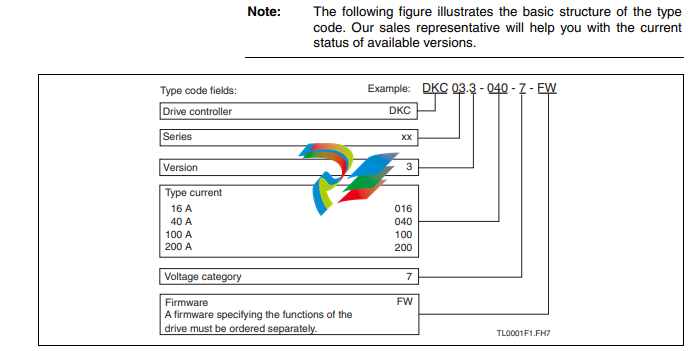
REXRTOHRexroth EcoDrive 03 Drive Controllers DKC**.3-040, -100, -200
• Fences and coverings must be strong enough to resist maximum possible momentum.
• Mount the emergency stop switch in the immediate reach of the operator. Verify that the
emergency stop works before startup. Don’t operate the device if the emergency stop is
not working.
• Isolate the drive power connection by means of an emergency stop circuit or use a safety
related starting lockout to prevent unintentional start.
• Make sure that the drives are brought to a safe standstill before accessing or entering the
danger zone.
• Additionally secure vertical axes against falling or dropping after switching off the motor
power by, for example:
– mechanically securing the vertical axes,
– adding an external braking/ arrester/ clamping mechanism or
– ensuring sufficient equilibration of the vertical axes.
• The standard equipment motor brake or an external brake controlled directly by the drive
controller are not sufficient to guarantee personal safety!
• Disconnect electrical power to the equipment using a master switch and secure the switch
against reconnection for:
– maintenance and repair work
– cleaning of equipment
– long periods of discontinued equipment use
• Prevent the operation of high-frequency, remote control and radio equipment near
electronics circuits and supply leads. If the use of such devices cannot be avoided, verify
the system and the installation for possible malfunctions in all possible positions of normal
use before initial startup. If necessary, perform a special electromagnetic compatibility
(EMC) test on the installation.
Magnetic and Electromagnetic Fields
WARNING
Health hazard for persons with heart pacemakers, metal implants and hearing aids in
proximity to electrical equipment!
• Persons with heart pacemakers and metal implants are not permitted to enter following
areas:
– Areas in which electrical equipment and parts are mounted, being operated or
commissioned.
– Areas in which parts of motors with permanent magnets are being stored, repaired or
mounted.
• If it is necessary for somebody with a pacemaker to enter such an area, a doctor must
be consulted prior to doing so. The interference immunity of present or future implanted
heart pacemakers differs greatly, so that no general rules can be given.
• Those with metal implants or metal pieces, as well as with hearing aids must consult a
doctor before they enter the areas described above.
Otherwise health hazards may occur.
Hot Parts
CAUTION
Hot surfaces at motor housings, on drive controllers or chokes! Danger of burns!
• Do not touch surfaces of device housings and chokes in the proximity of heat sources!
Danger of burns!
• Do not touch housing surfaces of motors! Danger of burns!
• According to operating conditions, temperatures can be higher than 60 °C (140 °F)
during or after operation.
• Before accessing motors after having switched them off, let them cool down for a
sufficiently long time. Cooling down can require up to 140 minutes! Roughly estimated,
the time required for cooling down is five times the thermal time constant specified in the
Technical Data.
• Wear safety gloves or do not work at hot surfaces.
• For certain applications, the manufacturer of the end product, machine or installation,
according to the respective safety regulations, has to take measures to avoid injuries
caused by burns in the end application. These measures can be, for example: warnings,
guards (shielding or barrier), technical documentation.
1.2 Appropriate Use
This product may only be used for the applications mentioned in the
reference documentations (see chapter “Reference Documentations”)
and under the described application, ambient and operating conditions.
Identification
2.1 Type Code


housing dimension; see related dimension sheet also 4) 5) see fig. "Air inlet and outlet of drive controller" 6) observe supply voltage for motor holding brakes 7) find value for control section in project planning manual 8) Suitable for use on a circuit capable of delivering not more than this
SCCR value, 600 V AC or less. The drive series shall be used with
listed AC input line fuses or listed circuit breakers specified in this
documentation.
9) DKC, CZM, BZM: DC bus L+, L-; Mains input L1, L2, L3 10) at PDC_cont 11) class J branch circuit fuse
12) find value for tightening torque in project planning manual, electrical
terminals
13) copper wire; PVC-insulation (conductor temperature 90 °C); Table
13.5.1; Ta ≤ 40 °C
14) plus dissipation of braking resistor
Abb. 3-1: UL ratings and dimensions

A: air intake
B: air outlet
C: mounting surface in control cabinet
dtop: distance top
dbot: distance bottom
Fig. 3-2: Air intake and air outlet at drive controller
Index
2
24V control voltage supply (+24V and 0V) 5-3
A
Appendix 6-1
Appropriate use 1-4
B
Basic connection of holding brake 5-13
Basic connection of motor power 5-13
Basic connection of motor temperature monitoring 5-13
Bb 5-5
DKC 5-5
BR+, BR- 5-11
C
Connection Choke (DR+, DR-) 5-16
Connection cross section
X1 5-3
X12 5-16
X5 5-7
X6 5-10
Connection Diagram 5-2
Connections 5-1
control cabinet
with multiple-line structure 5-20
Control Cabinet 5-20
Control voltage connections 5-3
Cooling Units 5-20
D
DC Bus Capacitors
discharging 6-1




























































































































